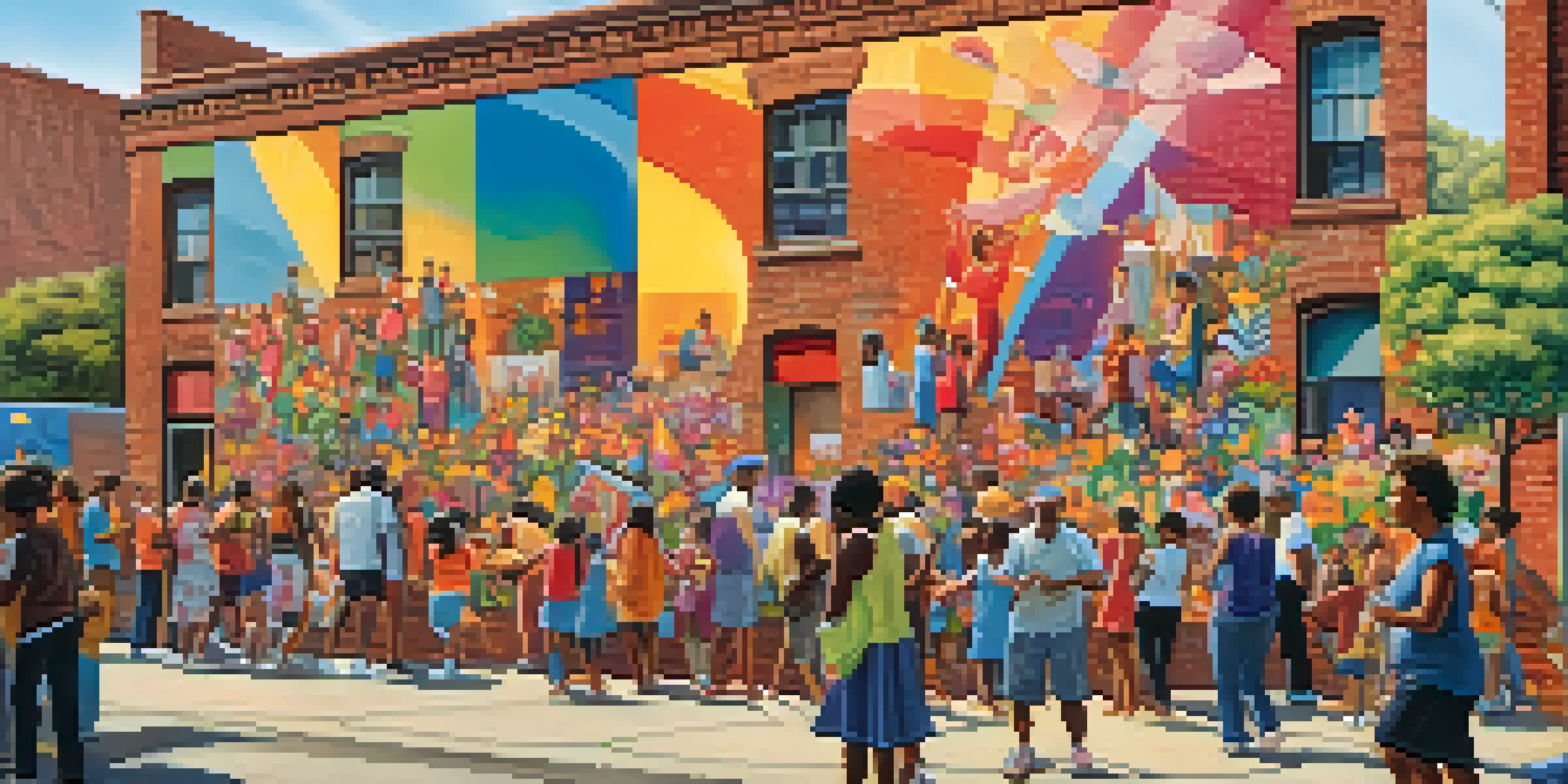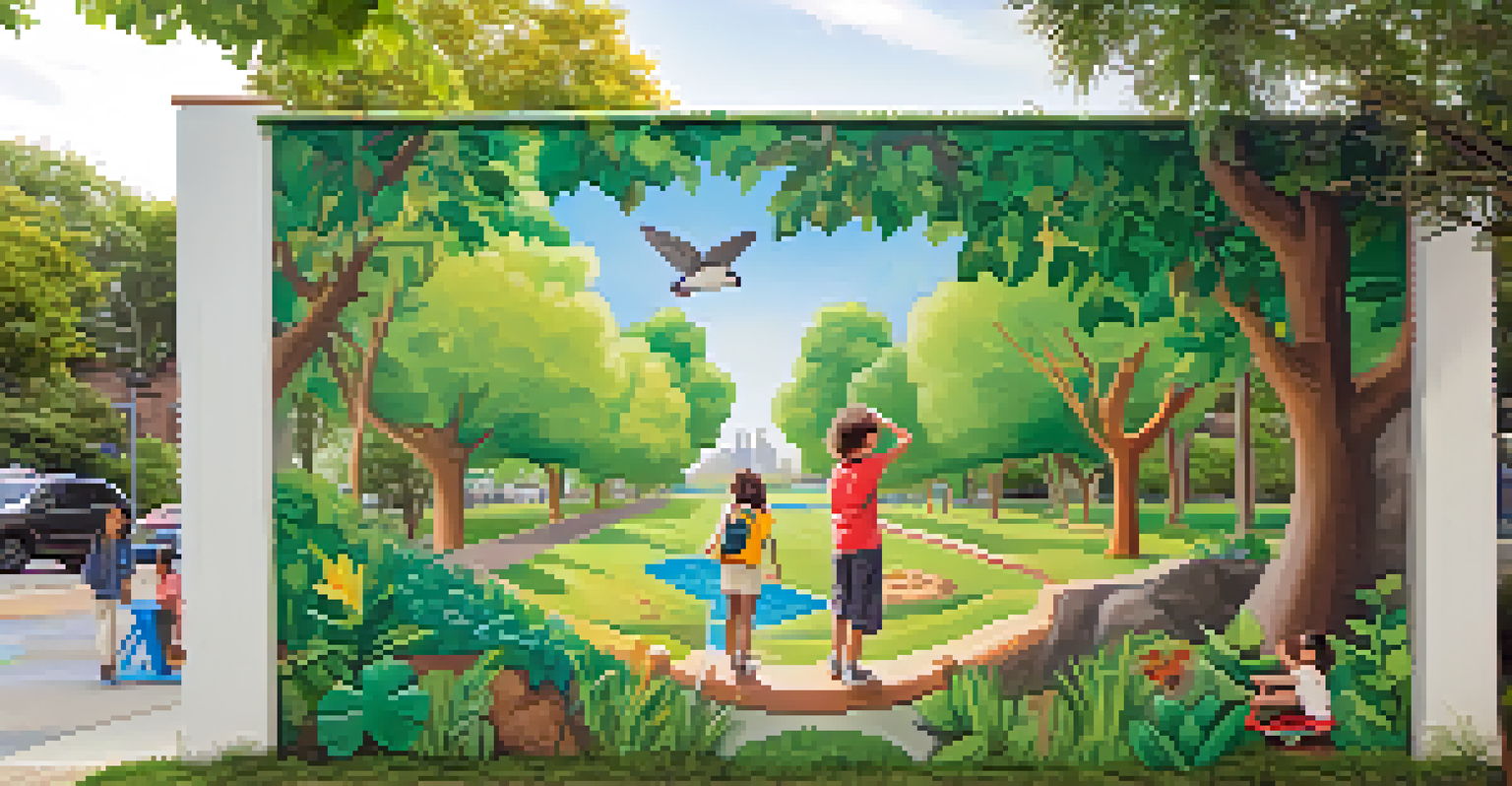Murals in Public Spaces: Enhancing Community Engagement

The Power of Murals in Urban Environments
Murals have the unique ability to transform bland urban spaces into vibrant galleries. They catch the eye and spark curiosity, inviting passersby to pause and appreciate the art. This transformation can change the narrative of a neighborhood, making it feel more welcoming and alive.
Murals are a way to communicate and express emotions that words often cannot.
As visual storytellers, murals convey messages about the community's history, culture, and aspirations. They often celebrate local heroes or highlight social issues, prompting conversations among residents and visitors alike. This often leads to a deeper understanding of the community's identity and values.
Moreover, murals can act as a catalyst for further artistic endeavors, encouraging local artists to showcase their talents. As more art emerges, the area develops a unique character that attracts tourists and art enthusiasts, ultimately boosting local economies.
Creating a Sense of Belonging Through Art
Murals can foster a sense of belonging among community members by reflecting their shared experiences and values. When people see their stories represented visually, it reinforces their connection to the place they call home. This sense of ownership can empower residents to take pride in their surroundings.

Community-led mural projects can further enhance this feeling of belonging. When local artists and residents collaborate on a mural, it becomes a collective expression of identity that strengthens community ties. These projects can also break down barriers, encouraging interaction among diverse groups.
Murals Enhance Community Identity
Murals visually capture a neighborhood's culture and values, fostering a sense of belonging among residents.
Additionally, the process of creating a mural can be a bonding experience. Workshops and planning sessions bring people together, allowing them to share ideas and develop friendships. This unity can lead to a more engaged and cohesive community.
Murals as Tools for Social Change
Many murals serve as powerful tools for social change, addressing critical issues such as inequality, environmental concerns, and mental health awareness. Artists often use their platforms to spark dialogue and inspire action, making art a voice for the voiceless. This can lead to increased awareness and mobilization within the community.
Art is not what you see, but what you make others see.
Murals can also serve as memorials, honoring victims of violence or injustice. These pieces not only commemorate lives lost but also serve as a reminder of the work still needed to create a more equitable society. By highlighting these issues, murals can encourage community members to engage in activism and support local initiatives.
Furthermore, these art pieces can attract attention from media and organizations, amplifying their messages beyond the local community. This increased visibility can lead to greater support for social movements, ultimately creating a ripple effect of change.
Engaging Youth Through Artistic Expression
Murals can play a significant role in engaging the youth of a community. By involving young people in the design and creation process, they gain valuable skills and experience while also expressing their creativity. This engagement can help foster a sense of pride and ownership among the younger generation.
Art education programs often partner with local organizations to facilitate mural projects, giving students a platform to voice their concerns and dreams. Such initiatives not only enhance their artistic skills but also empower them to be change-makers in their community. The process encourages collaboration and teamwork, essential skills for their future.
Art as a Catalyst for Change
Murals serve as powerful tools for social change, addressing critical issues and inspiring community activism.
Moreover, seeing their artwork displayed in public spaces can boost self-esteem and inspire other youths to explore their talents. This visibility can ignite a passion for the arts and motivate them to contribute positively to their community.
Economic Benefits of Public Murals
Public murals can significantly boost local economies by attracting tourists and art enthusiasts. When people come to view these vibrant displays, they often explore nearby businesses, restaurants, and shops, leading to increased foot traffic and sales. This economic boost can be especially beneficial for small, locally-owned establishments.
Additionally, murals can elevate property values in the surrounding area. A neighborhood known for its beautiful murals can become a desirable place to live, leading to increased demand for housing. This can generate more tax revenue for local governments, which can be reinvested into community programs and services.
Furthermore, mural festivals and events can draw large crowds, creating opportunities for local artists and vendors. These events not only celebrate art but also promote community pride, making them a win-win for everyone involved.
Murals and Community Identity
Murals play an essential role in shaping and expressing community identity. Each mural tells a story, capturing the essence of the neighborhood's culture, history, and values. This visual representation helps create a sense of place and belonging for residents while attracting visitors who want to experience the unique character of the area.
As community identities evolve, so do the murals that represent them. New artwork can reflect changes in demographics, cultural shifts, or emerging social movements. This adaptability keeps the community's narrative alive and relevant, fostering ongoing engagement from residents.
Economic Boost from Public Art
Public murals attract tourists and increase foot traffic, benefiting local businesses and elevating property values.
Moreover, murals can serve as a point of pride for the community, drawing people together to celebrate their shared identity. This collective pride can motivate residents to participate in further community-building efforts, creating a more cohesive and engaged population.
Preserving Murals: Challenges and Solutions
While murals bring numerous benefits, they also face challenges such as weathering, vandalism, and urban development. Over time, the vibrant colors can fade, and the surfaces may deteriorate, necessitating ongoing maintenance and preservation. Communities must find ways to protect these public artworks to ensure their longevity.
One solution is creating mural preservation programs that involve local artists and residents. By developing a plan for regular upkeep and restoration, communities can maintain the integrity of their murals while fostering a sense of stewardship. This can also provide opportunities for new generations of artists to learn from established muralists.

Additionally, engaging local governments and organizations in the preservation process can lead to the establishment of funding sources and partnerships. These collaborative efforts can ensure that murals continue to thrive, enhancing community engagement for years to come.